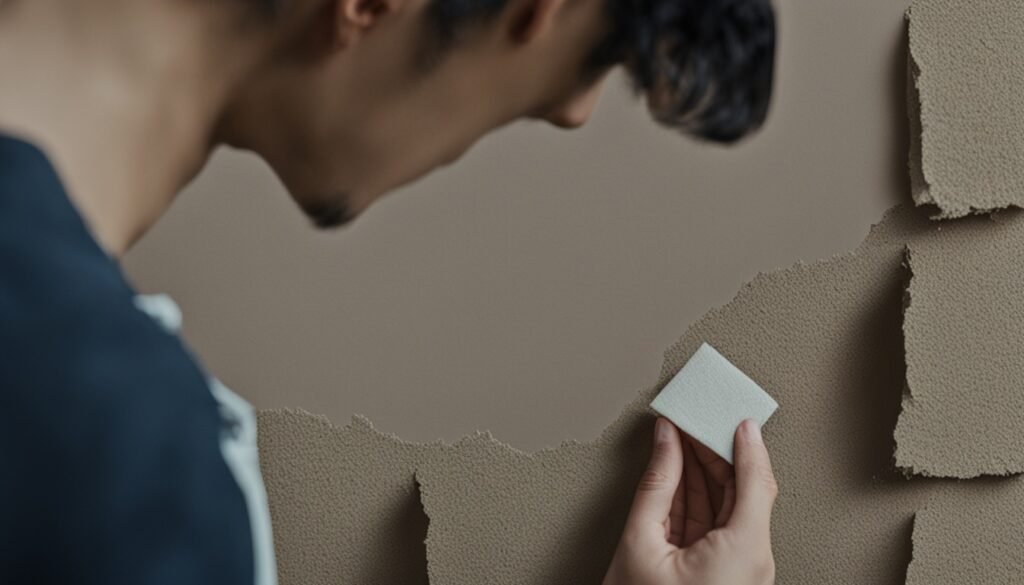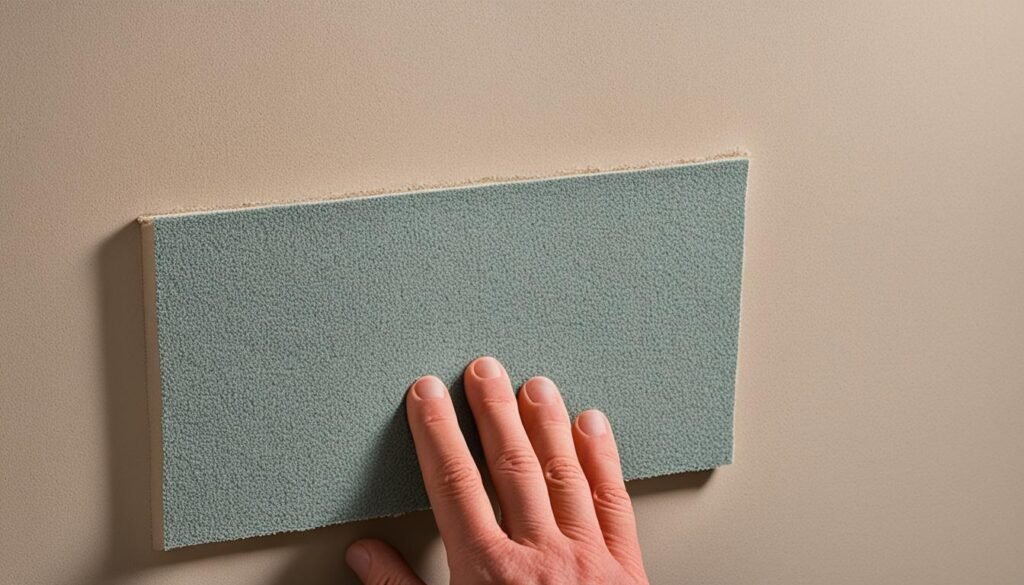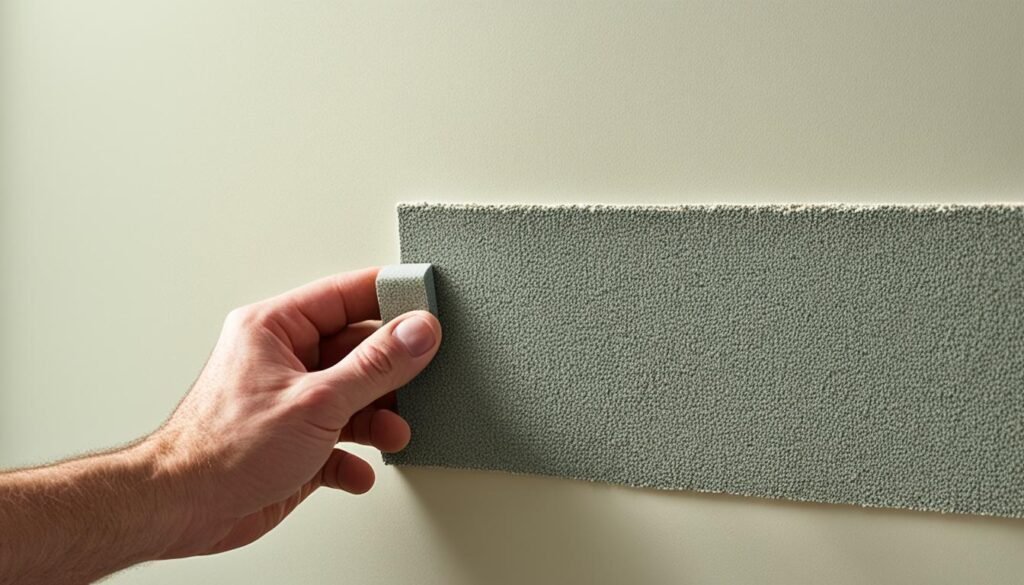Did you know the right grit sandpaper can change a paint job from perfect to a mess? It’s key to smooth out plaster walls before painting. This makes sure the surface is even and ready for paint.
Begin with coarse grit sandpaper (60-80) to fix any flaws. Then, switch to medium grit (100-120) for a smoother look. End with fine grit (150-180) for a surface that’s just right.
This process helps paint stick better and last longer. It stops paint from chipping or peeling. Always wear goggles and masks to protect yourself from dust.
Understanding Sandpaper Grit Ratings
When fixing plaster, knowing about sandpaper grit ratings is key. These numbers help you pick the right grit for your project. The grit size affects how well your work on plaster walls turns out.
What Do Grit Numbers Mean?
The grit number tells you how many abrasive particles are on the sandpaper. A low number means it’s coarse and good for removing a lot of material. A high number means it’s fine and great for smoothing and finishing.
40 grit is for quickly removing old finishes. 120 grit is used before the final coat. Knowing about these ratings helps you pick the right sandpaper for plaster repair.
Types of Grit for Different Applications
Choosing the right grit is key for sanding plaster well. Here are some grit levels for different tasks:
| Grit Level | Type | Uses |
|---|---|---|
| 24-40 | Extra Coarse | Floor sanding, rapid material removal. |
| 60 | Coarse | Rough shaping of wood, removing old finishes. |
| 80-100 | Medium | Final shaping, smoothing after coarse grit. |
| 120-220 | Fine | Final sanding before painting or refinishing. |
| 440 | Extra Fine | Sanding between coats of paint or varnish. |
This plaster sandpaper grit guide shows how the right grit can make your repair look great. The right grit ensures a smooth finish, ready for the next steps of your plastering project.
What Grit Sandpaper For Plaster
Choosing the right grit sandpaper for plaster walls is key to a smooth finish. Each grit level is best for different surfaces and results. It’s important to pick the right one.
Recommended Grit Levels
Start with the right grit sandpaper based on your plaster’s condition. Here’s a guide to the best grits:
| Grit Level | Category | Use Case |
|---|---|---|
| 40 | Extra Coarse | Substantial stripping of rough surfaces |
| 80 | Medium | Removing surface imperfections |
| 120 | Fine | Creating a surface key before first paint coat |
| 180 | Extra Fine | Smoothing light surface imperfections |
| 240-320 | Super Fine/Ultra Fine | Smoothing surface before final coat |
Choosing the Right Grit for Your Project
Think about your project when picking sandpaper grit for plaster walls. For big dips or bumps, use a coarse grit like 60-80. Then, switch to finer grits for a smooth finish, like 100-120.
This makes the surface ready for paint or finishes. Remember, using different grits is key for a great surface.

Best Sandpaper Types for Plaster Walls
Choosing the right sandpaper is key when working on plaster walls. Different types can greatly affect your finish’s quality. Knowing the differences between paper and cloth backing helps pick the best sandpaper for plaster walls. Each type has its own benefits for different jobs.
Paper vs. Cloth Backing
Paper-backed sandpaper is great for light jobs. It bends easily and fits well around curves and corners. This is very useful for sanding detailed areas.
Cloth-backed sandpaper is more durable and doesn’t tear easily. It’s best for removing a lot of material, especially with coarse grit for plaster. For big areas or hard surfaces, cloth-backed sandpaper lasts longer.
Aluminium Oxide and Zirconia Alumina
Aluminium Oxide is cool-cutting and lasts a long time. It’s great for general sanding. Zirconia Alumina is for tough jobs. It keeps sharpening itself on hard surfaces.
Choosing the right grit for plaster can make sanding better and improve your results.

| Sandpaper Type | Backing Type | Best Use |
|---|---|---|
| Aluminium Oxide | Paper | General sanding |
| Zirconia Alumina | Cloth | Tough sanding tasks |
| Coarse Grit (80-100) | Paper/Cloth | Initial material removal |
| Medium Grit (120-150) | Paper/Cloth | Smoothing surfaces |
| Fine Grit (180-220) | Paper/Cloth | Final finishing touches |
How to Choose Sandpaper for Plaster
Choosing the right sandpaper for plaster is key to a great finish. You need to know the plaster’s condition and the surface you want. This helps pick the right grit size.
Factors to Consider When Selecting Grit
The grit size tells you how many sharp particles are on the sandpaper. For starting on plaster, use coarse grit, like 60-80, to remove big flaws. Then, switch to medium grit, 100-120, for smaller imperfections.
For the final step, use fine grit, 150-220, for a smooth finish. Remember, the grit you choose depends on the sanding’s purpose in plastering. Each grit level plays a part in getting a perfect finish.
Different Functions of Sanding in Plastering
Sanding does many things in plastering. Coarse grits are great for heavy sanding and preparing the surface. Medium grits smooth out the surface and fix small issues.
Fine grits make the surface ready for paint. Knowing these uses helps you pick the right sandpaper for your project. Check out how to choose sandpaper for plaster for more info.
Conclusion
Choosing the right grit sandpaper for plaster is key to a smooth finish on your walls. It’s important for both small repairs and big projects. Aim for grits between 150 and 220 for the best look.
For small jobs, you might only need 100 to 120 grit sandpaper. Knowing the grit levels helps you at each step of your project. Coarse grits are great for removing old paint or material fast.
Finer grits give you that shiny finish. For fixing different drywall issues, the best sandpaper can change. But, 180 grit is often the top choice for final sanding.
If you need help with plastering, get expert advice. Visit Local Plasterer for skilled help. They can guide you to the best plastering solutions with quality and care.

